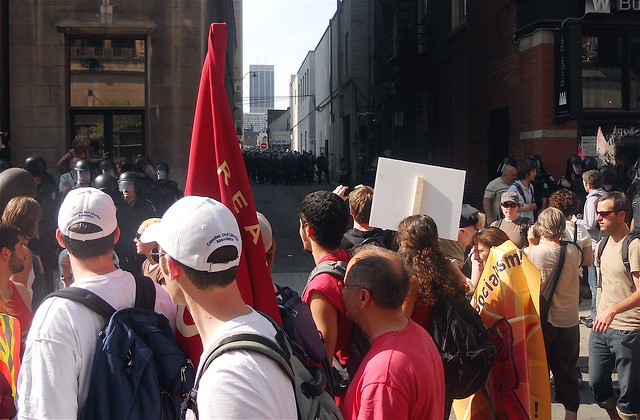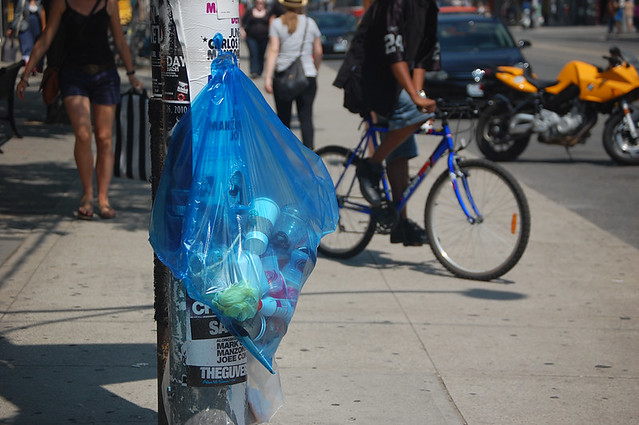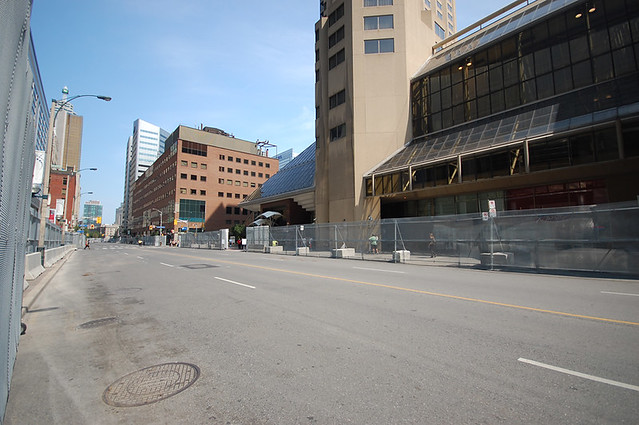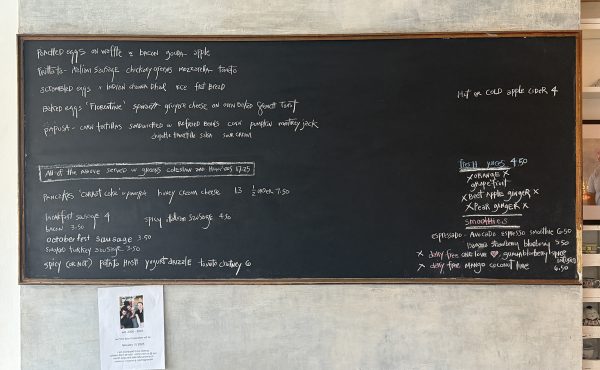It was an eerie experience traversing Toronto’s should-be-bustling downtown streets in the days leading up to the G20. But it wasn’t freedom I enjoyed, cycling the city’s main throughfares free of traffic — it was the apprehension and uneasiness that accompany urban desolation. As an abundance of city planners since Jane Jacobs have asserted (and as The Star pointed out in post-G20 editorial), people keep a city safe. So when Toronto residents and business owners retreated, imbued with the message that their streets were about to turn ugly, that’s exactly what we left them vulnerable to do.
The tactics of looters and vandals have been discussed elsewhere, but, as I witnessed throughout the weekend, it was the police who best utilized our city’s infrastructure for the purposes of intimidation and violence. As a participant in Friday’s and Saturday’s demonstrations, I was shocked to see the police appropriating those things we rely on and enjoy about life in this city, turning them into tools used against us.

Bicycles: While Sunday’s “bike block” demonstration remained peaceful, bicycles have had contentious presence throughout the weekend’s events. The double function of bicycles as transportation and crowd control has been utilized to the fullest by police, who corralled crowds at Friday’s demonstration using a make-shift fence of bikes, pushed groups of participants back using bikes as shields, and piled bikes in front of groups as barriers on Saturday.

The TTC: After spending hours outside in the rain, dozens of detainees were transported via chartered TTC buses from Spadina and Queen to the detention centre at Eastern Avenue on Sunday night. On both Friday and Saturday, participants in the rallies reported seeing police pile out of buses. And streetcars — the gentle giant of TTC vehicles — have been stationed at crucial junctures throughout the downtown.
While it may be that these stationary vehicles were the result of route interruptions, police haven’t hesitated to make use of such convenient obstacles. As Saturday’s march moved west on Queen, approaching Spadina, a cluster of streetcars signaled to the group that continuing would mean splitting to navigate such bulky barriers. Riot police emerged from behind and congregated in front of these Toronto transit icons, where they stayed in formation for the duration of the march. As protesters turned to move east and north, police here dispersed, while the streetcars remained.

Alley-ways: The first clash between participants and police that I witnessed (resulting in a small number of arrests) happened at Friday’s march, on College just past Yonge, on the sidewalk front of the entranceway to College Park. As a pool of rally participants gathered around the skirmish, chanting “let him go,” after first of the protesters was pinned and arrested, a swath of police officers appeared suddenly up the alley directly across from where the action was taking place. With a group of marchers caught between the alley and the action on the opposite sidewalk, fear mounted as the group of approximately 50 police approached. The march scurried by and pending conflict seemed to subside.
This particular alley’s proximity to Toronto Police Headquarters prompted many of us to look out for the use of other less obvious routes by police, taking note of the extensive traversal and occupation of alley-ways, side-streets, and smaller pathways in the downtown over the coming days.

Trash bins and street furniture: Okay, so Toronto’s new(ish) trash bins wouldn’t normally grace a list of things I love and enjoy about this city, but their pure necessity is obvious to any city dweller. In a preemptive (and, dare I say, provocative) move that only increased the spooky bareness of our streets, street furniture of all shapes and heft-able sizes — including trash bins, benches, bus shelters, and newspaper boxes — was removed within the security perimeter. Did this deter certain groups and individuals from inflicting vandalism on the downtown? Did it, on the other hand, deter residents and business owners from going out and making use of the empty streetscapes?

With Toronto’s spaces and streets doctored in this way, it’s no surprise to me that alongside the criticism directed towards the Feds, Mayor Miller and Police Chief Bill Blair are facing comparable flak. As Monday’s rally in solidarity with those who had been detained gathered outside of Toronto Police Headquarters and looped down to City Hall, a pertinent modification of an age-old protest chant rang through the crowd: “Whose city?”






9 comments
Speaking of the appropriation of progressives, you might have added:
Bill Blair – by far the best police chief this City has had in living memory, now a mouthpiece for the clampdown on peaceful protest. Protesters demand his resignation, but if Fantino had been in charge, they would be complaining about broken skulls instead of non-vegan food at the detention centre.
Adam Vaughan – one of the most effective critics of G20 planning in the run-up, now going mumbly about police tactics and nowhere to be seen during the detainment of pedestrians just footsteps away from City Hall. Vaughan slyly notes the presence of OPP badges during a clampdown and demands transparency from Queen’s Park. But as a member of the Police Services Board, he apparently can’t demand the same from his own force.
David Miller – managed to look even worse than he did after the strike
Joe Pantalone – played cricket during the riots, then retyped David Miller’s lame press release praising the police
All this while Rob Ford holds a lead in the polls!
Toronto’s progressive left have rarely looked like such a bunch of idiots. Thanks, TCMN and other riot-apologists! Good work!
The police got out foxed by a group that realized 5000 police officers could not protect all of Toronto’s intersections.
The police and protesters use the same tactics; bicycles for getting around, cameras for presenting their side of the events.
Sadly but realistically Toronto Police Chief Bill Blair must resign or be removed from office.
He admitted in a Globe and Mail report knowingly and willfully misleading the public and his officers about the law to suit his own ends. In doing so, he broke constitutional law – Canadian Charter of Rights and Freedoms – http://www.efc.ca/pages/law/charter/charter.sect.html My full argument is here: http://davenportdemocracy.blogspot.com/2010/06/why-police-chief-blair-must-resign.html
The Globe’s ‘one person’ who was assaulted and detained at Sunday’s group bike ride is Geoffrey Bercarich, one of the key contributors to the Bike Pirates community bicycle shop.
Of course all charges were dropped after keeping him caged for 10 hours.
I hope the downturn in the Toronto legal business means more pro bono work, cause there has been a lot of egregious policing in this city.
Re Ken:
This is the same guy who used a missing white girl as an excuse to search people’s homes without a warrant or reason. Bill Blair doesn’t give two craps about civil liberties or freedoms of citizens.
Re: John,
As I have mentioned before, it is worth remembering that George Smitherman is the only major mayoral candidate who has called for an inquiry and condemned police tactics during the G20.
He could win. Remember that.
Removing street furniture is an obvious security measure. There were no big fires in the latest Montreal riot thanks to measures like this.
If I had to choose between preventing fires and making people like you feel happy and warm inside and stuff, I would prevent fires. You should be happy to live in a country where basic security measures are followed. Why are we immigrants from the 3rd world the only ones who appreciate this?
I’m sure you agree that those who vandalized were there to vandalize and would have done it anyway, whether the streets looked pretty or not. So I’m sure you agree that not following those security measures would have made things much uglier.
And yes, they had to “deter residents and business owners from going out and making use of the empty streetscapes.” There were people coming to Toronto in order to commit dangerous vandalism, and nothing would have changed their mind, so they had to keep normal people (and by normal I mean NORMAL; those who understand that trashing a city will not make a difference in their protest) away from the danger zone.
In my humble opinion you are complaining about all the wrong things, but you are welcome to explain why I’m wrong. On the other hand it would be nice if Spacing (being a creative space) makes a proposal for better security measures during these events rather than just complaining about what they did. I guess that is a lot more difficult.
The Vancouver Olympics had similar draw for anti-capitalist ‘casseurs’, and inevitably they broke some stuff too.
However, the police managed to split them up, corner them, and arrest several, in part because the downtown was full of citizens who didn’t appreciate their city being trashed. Frankly, some of the black bloc got their asses kicked by locals.
As you can guess I’m a believer in Jane Jacobs’ “eyes on the street” theory of safety. When downtown becomes a ghost town, it doesn’t matter how many riot cops you pay triple overtime.
So in case it wasn’t clear – my proposal for better security measures during these events is to try and exert peer pressure, bring civic-minded people into downtown, and exert some moral rather than military pressure.